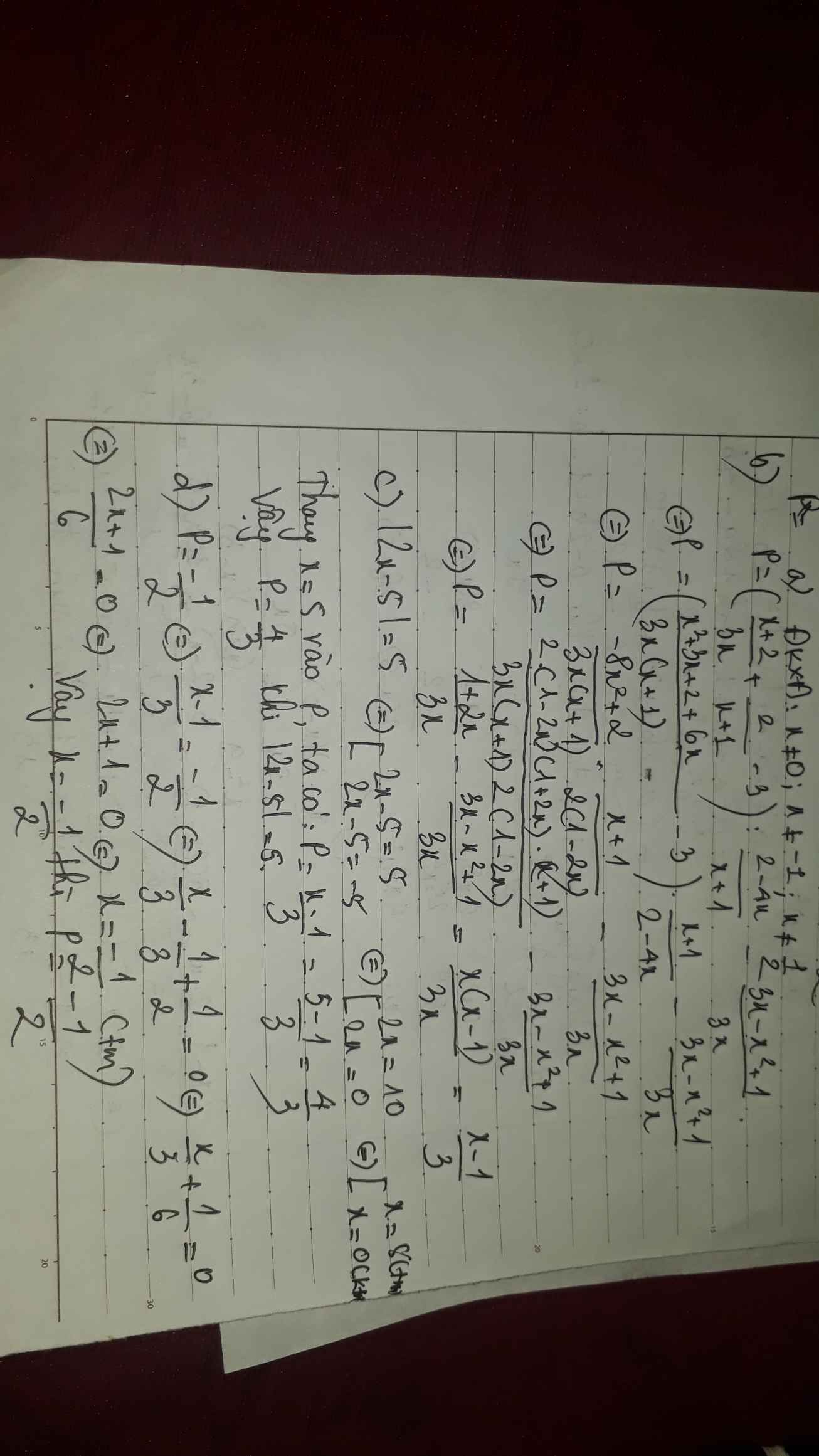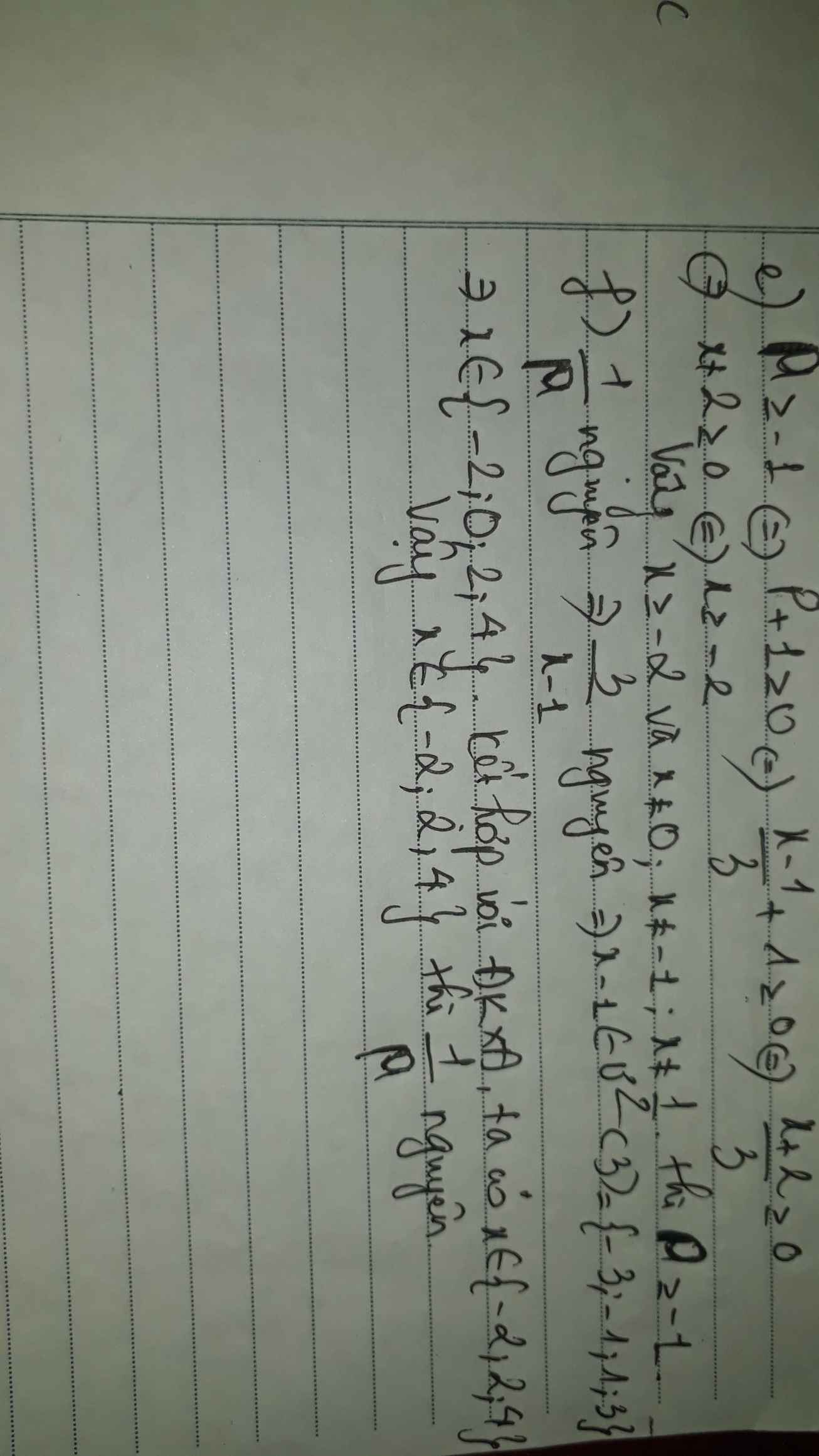Hãy nhập câu hỏi của bạn vào đây, nếu là tài khoản VIP, bạn sẽ được ưu tiên trả lời.

a: \(A=4x-3x^2+20-15x-9x^2-12x-4+\left(2x+1\right)^3-\left(8x^3-1\right)\)
\(=-12x^2-23x+16+8x^3+12x^2+6x+1-8x^3+1\)
\(=-17x+18\)

(a) Điều kiện : \(x\ne-1.\)
Ta có : \(P=\dfrac{x^4+x}{x^2-x+1}+1-\dfrac{2x^2+3x+1}{x+1}\)
\(=\dfrac{x\left(x^3+1\right)}{x^2-x+1}+1-\dfrac{\left(2x+1\right)\left(x+1\right)}{x+1}\)
\(=\dfrac{x\left(x+1\right)\left(x^2-x+1\right)}{x^2-x+1}+1-\left(2x+1\right)\)
\(=x\left(x+1\right)+1-2x-1\)
\(=x^2-x.\)
Vậy : Với mọi \(x\ne-1\) thì \(P=x^2-x.\)
(b) Ta có : \(P=x^2-x\)
\(=\left[x^2-2\cdot x\cdot\dfrac{1}{2}+\left(\dfrac{1}{2}\right)^2\right]-\left(\dfrac{1}{2}\right)^2\)
\(=\left(x-\dfrac{1}{2}\right)^2-\dfrac{1}{4}\ge-\dfrac{1}{4}\)
Vậy : \(MinP=-\dfrac{1}{4}.\) Dấu đẳng thức xảy ra khi và chỉ khi \(x=\dfrac{1}{2}.\)

a: \(P=\dfrac{2x^2-1-x^2+1+3x}{x\left(x+1\right)}=\dfrac{x^2+3x}{x\left(x+1\right)}=\dfrac{x+3}{x+1}\)

a: \(A=\dfrac{x^2-2x+2x^2+4x-3x^2-4}{\left(x-2\right)\left(x+2\right)}=\dfrac{2x-4}{\left(x-2\right)\left(x+2\right)}=\dfrac{2}{x+2}\)
a, \(\dfrac{x}{x+2}\) + \(\dfrac{2x}{x-2}\) -\(\dfrac{3x^2-4}{x^2-4}\)
= \(\dfrac{x}{x+2}+\dfrac{2x}{x-2}-\dfrac{3x^2+4}{x^2-4}\)
= \(\dfrac{x}{x+2}+\dfrac{2x}{x-2}-\dfrac{3x^2+4}{\left(x+2\right)\left(x-2\right)}\)
= \(\dfrac{x\left(x-2\right)+2x\left(x+2\right)-3x^2-4}{\left(x+2\right)\left(x-2\right)}\)
= \(\dfrac{2x-4}{\left(x+2\right)\left(x-2\right)}=\dfrac{2\left(x-2\right)}{\left(x+2\right)\left(x-2\right)}=\dfrac{2}{x+2}\)
Có vài bước mình làm tắc á nha :>

a: \(A=\left(\dfrac{x}{x^2-4}+\dfrac{4}{x-2}+\dfrac{1}{x+2}\right):\dfrac{3x+3}{x^2+2x}\)
\(=\dfrac{x+4x+8+x-2}{\left(x-2\right)\left(x+2\right)}\cdot\dfrac{x\left(x+2\right)}{3\left(x+1\right)}\)
\(=\dfrac{6\left(x+1\right)\cdot x\left(x+2\right)}{3\left(x+1\right)\left(x-2\right)\left(x+2\right)}\)
\(=\dfrac{2x}{x-2}\)

\(a,P=\left[\dfrac{x+1}{3x\left(x+1\right)}-\dfrac{2x-1}{3x\left(2x-1\right)}-1\right]\cdot\dfrac{2x}{1-x}\left(x\ne1;x\ne-1;x\ne0\right)\\ P=\left(\dfrac{1}{3x}-\dfrac{1}{3x}-1\right)\cdot\dfrac{2x}{1-x}\\ P=-1\cdot\dfrac{2x}{1-x}=\dfrac{2x}{x-1}\\ b,P=2+\dfrac{2}{x-1}\in Z\\ \Leftrightarrow x-1\inƯ\left(2\right)=\left\{-2;-1;1;2\right\}\\ \Leftrightarrow x\in\left\{2;3\right\}\left(x\ne-1;x\ne0\right)\\ c,P\le1\Leftrightarrow\dfrac{2x}{x-1}-1\le0\\ \Leftrightarrow\dfrac{x+1}{x-1}\le0\\ \Leftrightarrow\left[{}\begin{matrix}\left\{{}\begin{matrix}x+1\le0\\x-1>0\end{matrix}\right.\\\left\{{}\begin{matrix}x+1\ge0\\x-1< 0\end{matrix}\right.\end{matrix}\right.\Leftrightarrow-1\le x< 1\)
a: \(P=\left(\dfrac{x+1}{3x\left(x+1\right)}-\dfrac{2x-1}{3x\left(2x-1\right)}-1\right)\cdot\dfrac{2x}{x-1}\)
\(=\dfrac{1-1-3x}{3x}\cdot\dfrac{2x}{x-1}\)
\(=\dfrac{-3x}{3x}\cdot\dfrac{2x}{x-1}=\dfrac{-2x}{x-1}\)


a) P = 2x(-3x + 2) - (x + 2)² + 8x² - 1
= -6x² + 4x - x² - 4x - 4 + 8x² - 1
= (-6x² - x² + 8x²) + (4x - 4x) + (-4 - 1)
= x² - 5
b) Thay x = 3 vào P, ta được:
P = 3² - 5
= 4
c) Để P = -1 thì x² - 5 = -1
x² = -1 + 5
x² = 4
x = 2 hoặc x = -2
Vậy x = 2; x = -2 thì P = -1
\(a,P=2x\left(-3x+2\right)-\left(x+2\right)^2+8x^2-1\)
\(=-6x^2+4x-\left(x^2+4x+4\right)+8x^2-1\)
\(=-6x^2+4x-x^2-4x-4+8x^2-1\)
\(=\left(-6x^2-x^2+8x^2\right) +\left(4x-4x\right)+\left(-4-1\right)\)
\(=x^2-5\)
Vậy \(P=x^2-5\).
\(b,\) Ta có: \(P=x^2-5\)
Thay \(x=3\) vào \(P\), ta được:
\(P=3^2-5=9-5=4\)
Vậy \(P=4\) khi \(x=3\).
\(c,\) Có: \(P=-1\)
\(\Leftrightarrow x^2-5=-1\)
\(\Leftrightarrow x^2=4\)
\(\Leftrightarrow\left[{}\begin{matrix}x=2\\x=-2\end{matrix}\right.\)
Vậy \(P=-1\) khi \(x\in\left\{2;-2\right\}\).
#\(Toru\)